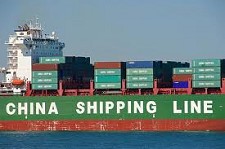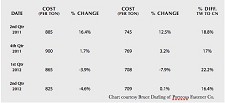4/3/2012 4:39:00 PM
HEADLINES
Darling: Asian Steel Producers Adjust to New Global Economy
![]()
Fastener prices are up because steel prices are up over the past decade, Bruce Darling told the Southwestern Fastener Association.
• At the end of 2003, the cost of steel in Taiwan was $364 per ton and China was $375 per ton. For the second quarter of 2012 the prices are $825 in Taiwan and $709 in China. Both prices are down from the end of 2011. Fluctuation of the U.S. dollar drove up steel prices in 2010 and 2011 and then lower this year.
• First quarter 2012 steel prices were sliding due to low demand. Darling, vice president of materials management for Porteous Fastener Company, noted that this is the price level at which distributors are now receiving shipments from fastener importers.
• Q2 2012 steel prices are steady and “reflect the U.S. dollar appreciation against the Taiwan dollar,” Darling explained. “This is the price at which importers are placing current purchase orders.”
Darling noted that US dollar fluctuations affect Taiwan more than China. Darling recalled a September 2011 Wall Street Journal article reported that new research suggests that the damage to the U.S. from cheap Chinese imports “has been deeper than previously supposed. The speed at which China has surged as an exporter is overwhelming the normal process.”
The U.S. economy has had higher unemployment insurance, food stamps and disability payments. “These higher costs lead to higher taxes and reduces the incentive to work, making the economy less efficient,” Darling said.
During the fourth quarter of 2011 the U.S. continued to pressure China to raise the value of its Yuan, but the Ministry of Foreign Affairs responded that rapid Yuan appreciation was out of the question.
“The Chinese economy is slowing down and there is growing concern over lower export numbers caused by the stagnation in Europe and the U.S.,” Darling observed. “Since 2005, the Yuan has risen about 30% against the U.S. dollar and that is seen as ‘reasonable’ in the eyes of the Chinese government.
“Continued gradual reform of the Yuan’s value is seen as the prudent policy,” Darling added.
During the final quarter of 2011, U.S. steelmakers found demand was increasing due to car, farm gear and oil drilling equipment sales.
“There has been new investment in steel production capacity in the U.S.”
As 2012 opened, Canadian employers Caterpillar and Rio Tinto sought labor cost savings – including locking out workers.
Taiwan’s China Steel announced plans to close its oldest plant for maintenance in June.
CSC increased its production of 1/2 and 5/8 diameter wire rod in anticipation and fastener manufacturers are stockpiling wire rod.
“In further talks with suppliers, we expect little shortage caused by this maintenance shut down,” Darling has found.
• In March 2012 China’s Premier Wen Jiabao projected a 7.5% growth target the National People’s Congress projected a 7.5% growth target for 2012.
“This slowing of their economy will certainly have an effect on countries like Australia, Brazil and the oil states who have been supplying the massive amounts of commodities fueling China’s infrastructure, power generation and exports,” Darling observed.
“A China that relies more on consumer spending may pollute less, easing global environmental worries and produce more jobs.”
Taiwan: Steel Prices to Rise in Q3 – Taiwan steel prices are expected to remain steady this quarter and begin to rise in Q3.
“No shortages are expected as demand is not great,” Darling noted. Taiwan wages will rise 3% to 5%, partially due to the rising minimum wage.
“Qualified workers will continue to be hard to find as young people would rather work in service jobs than in a hot, dirty manufacturing environment,” Darling finds. However, he rated it a “concern” rather than a “major problem.”
Even though there is over capacity for ocean freight shipping, the “expectation is that ocean rates will increase.” Global fuel prices are up and are likely to lead to additional fastener cost increases.
Taiwan’s election is over “so prices will now be easier to pass along,” Darling noted.
Some Taiwan vendors have gained customers from the closing of Heads & Threads International. “Those that did do business with HTI say the losses were harmful to their cash flow and have, in some cases, caused a change in relationship with their banks,” Darling finds. “Bank costs are rising.” Overall inflation in Taiwan will keep long range prices headed up. Though inflation is gradual, “a major steel price change is immediate.”
Taiwan fastener executives are “optimistic about the U.S. market as opposed to Europe.”
China: Steel Prices to Be Stable – The expectation is that steel prices in China “will move little over the net six to nine months,” Darling predicted.
European volume remains slow and the U.S. demand “while up, is not booming. Steel is in oversupply and what little increases that might occur will be partially absorbed by wire suppliers and the factories themselves.”
The one area of question is if the Chinese government changes its real estate policy to allow significant increases in speculative building, Darling suggested.
China’s wages will rise 10% to 20% annually for the foreseeable future, Darling forecast. “Wage costs are making it more difficult to run a profitable Chinese factory. Workers continue to be plentiful as farmers would rather have a factory job.”
India: Searching for Good Suppliers – As Porteous Fastener expands its socket line, it is importing more from India.
“There are good factories in India, but you need to search them out,” Darling found.
India’s steel prices “are not always stable and small things like labeling, pallets, payment terms and box quality seem to become issues,” he added.
India’s transportation costs – both ocean freight and diesel – are increasing, Darling pointed out.
Thailand: Steel Prices Steady – Darling termed the Thailand supply as “fairly steady.”
One supplier to Porteous told Darling that they “see little pressure for steel price increases. Supply is sufficient and no shortages are expected.”
Labor costs will increase as inflation in Asia continues to go up, Darling said. ©2012 GlobalFastenerNews.com
Related Stories:



Share: